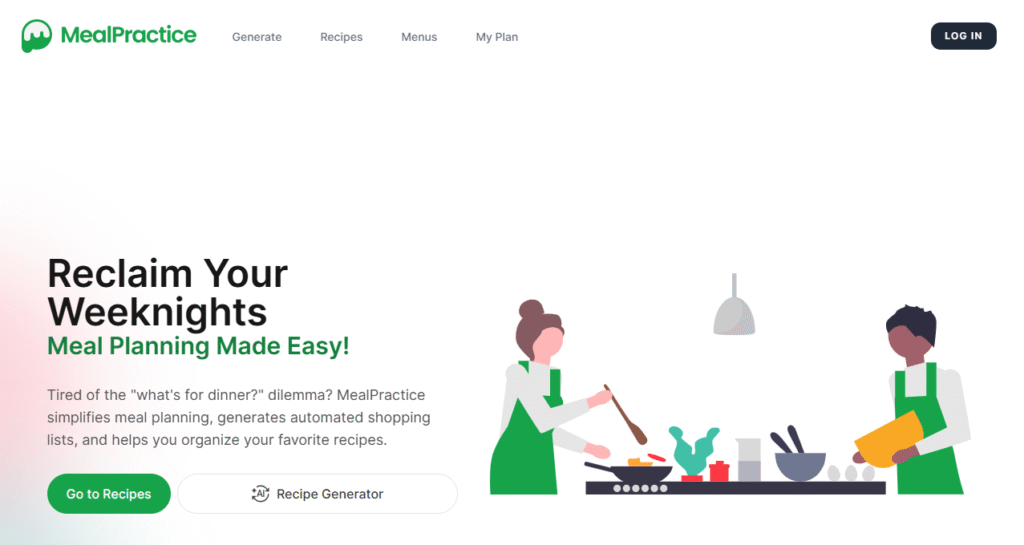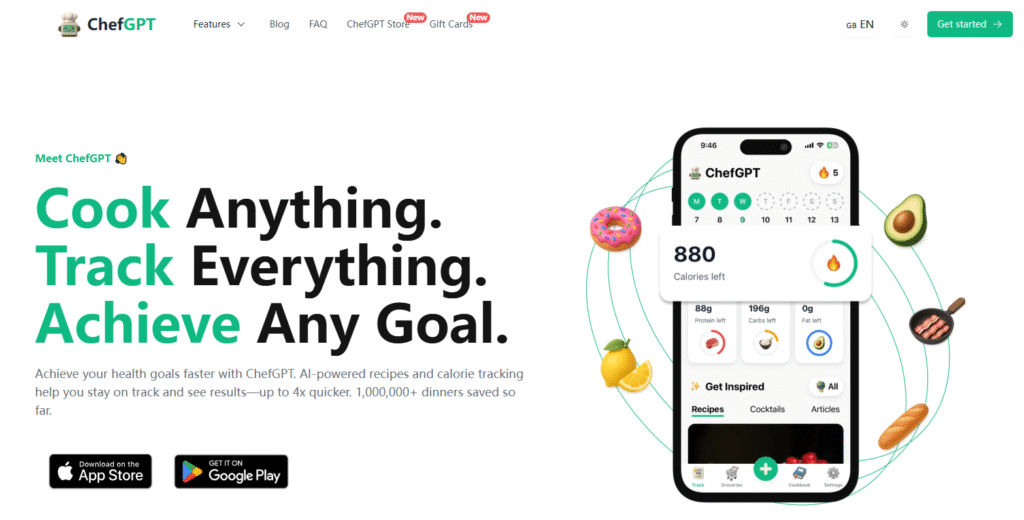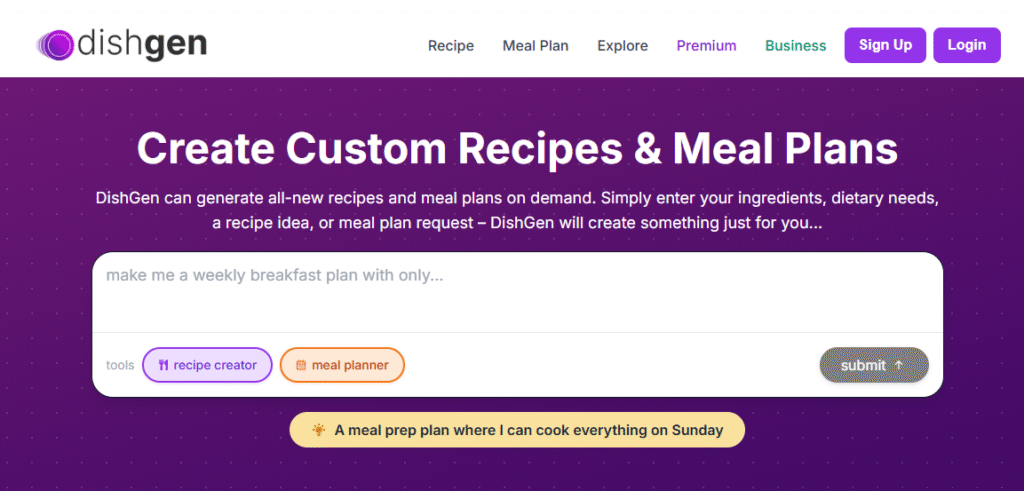Staring at a random collection of ingredients like chickpeas, slightly tired broccoli, and a lonely-looking lemon, wondering if they could possibly transform into a delicious dinner?
This common kitchen dilemma is exactly why the best AI recipe organizer tools have evolved from interesting novelties into essential culinary partners that genuinely understand cooking logic.
For those who’ve already embraced AI tools like ChatGPT for work and Midjourney for creative projects, it’s time to bring that same smart automation into your kitchen.
What Is an AI Recipe Generator?
AI recipe generators use sophisticated machine learning algorithms trained on extensive culinary databases to analyze your available ingredients, dietary preferences, and even what needs to be used before it spoils.
Unlike traditional recipe websites that offer static suggestions, the best AI recipe organizer dynamically combines your specific ingredients, nutritional goals, flavor preferences, and dietary restrictions to create personalized meal ideas from scratch.
Modern AI recipe organizers do more than just suggest dishes—they generate complete cooking workflows including preparation times, portion calculations, and even beverage pairings.
This transforms that frustrating “I have no idea what to make” moment into “dinner is served” in under thirty seconds. Whether you’re dealing with limited pantry items or specific nutritional requirements, these tools provide customized solutions that adapt to your unique cooking situation.
You Might Also Like: Best AI Scheduling Assistant
Why Use an AI Recipe Generator?
The first compelling reason to use an AI recipe generator is the incredible time savings. No more scrolling endlessly through recipe sites at 6 PM only to discover you’re missing a crucial ingredient. These tools deliver immediate, actionable recipes based on what you actually have available, turning meal planning from a chore into a quick, efficient process.
Secondly, these tools combat food waste with impressive efficiency. That half-empty container of yogurt and those slightly wilted vegetables? Your best AI recipe organizer will find delicious purposes for them before they head to the compost bin. Additionally, these platforms spark culinary creativity by suggesting flavor combinations you might never have considered—like the surprisingly delicious pairing of miso and caramel for roasted vegetables.
Finally, the dietary customization happens automatically. Whether you’re following a keto, vegan, or diabetic-friendly diet, the algorithm adapts recipes without requiring manual ingredient substitutions. This makes maintaining specific dietary patterns significantly easier and more enjoyable.
6 Best AI Recipe Organizers for Home Cooks
1. cookAIfood

cookAIfood feels like having a Michelin-starred chef who also happens to be a data scientist in your kitchen. This comprehensive platform generates recipes from ingredient lists, dietary preferences, or even simple photos of your fridge contents.
Its standout feature is designing complete multi-course menus for dinner parties or weekly meal preparation, complete with timing coordination to ensure everything reaches the table perfectly heated. For food content creators, the integrated high-definition food photography feature is revolutionary—producing professional-looking images without needing a photographer.
Key features:
- Creates personalized recipes from text, dietary filters, or fridge photos
- Designs coordinated multi-course menus with automated timing
- Generates publish-ready HD food photography for social media
- Supports both casual home cooking and professional chef workflows
2. MealPractice

Designed for busy individuals, MealPractice transforms meal planning from a dreaded weekly chore into a quick three-minute task. The AI system learns your protein preferences, nutritional style, and favorite cuisines, then generates a week of varied meals that work well together.
The intuitive drag-and-drop calendar interface allows you to reschedule meals without disrupting your plan’s logical flow. Integration with grocery delivery services means your shopping list arrives perfectly portioned for your household size.
Key features:
- Drag-and-drop weekly meal planning with automatic portion scaling
- Automated shopping lists syncing with Instacart and Amazon Fresh
- Collaborative workspaces for sharing plans with family members
- Nutritional analytics tracking macros and dietary goal progress
3. ChefGPT

ChefGPT functions like a culinary Swiss Army knife with specialized modes for different cooking scenarios. Its PantryChef mode creates meals from whatever you already have in your cabinets, while MasterChef mode acts as a flavor-discovery engine suggesting recipes that expand your palate.
MacrosChef mode benefits fitness enthusiasts by designing meals with precise protein-carb-fat ratios. The wine pairing suggestions draw from a sophisticated database considering both your dish and personal preferences.
Key features:
- PantryChef mode creates recipes from available ingredients
- MasterChef mode suggests flavor-expanding recipes
- MacrosChef mode builds meals around specific nutritional targets
- MealPlanChef mode generates diet-specific plans aligned with fitness goals
4. DishGen

DishGen embraces beautiful simplicity: input your ingredients and receive instant inspiration from its extensive recipe database. No mandatory sign-ups or spam emails—just immediate suggestions.
The platform particularly shines when repurposing leftovers, creatively transforming yesterday’s roasted chicken into today’s tacos or soup. While the free version is surprisingly capable, creating an account unlocks saving and sharing features plus access to the community-generated Recipe Bank.
Key features:
- Instant recipe generation without account requirements
- Recipe Bank with community-curated suggestions
- Intelligent leftover repurposing to minimize food waste
- Clean, distraction-free interface focused on speed
5. Let’s Foodie

Let’s Foodie positions itself as the friendly cooking coach for technique-curious home chefs. Beyond generating recipes, it provides contextual cooking tips—like how to properly chiffonade basil or why salting eggplant before roasting matters.
The AI learns from your cooking history, gradually refining suggestions to match your evolving skill level and flavor preferences. If you’ve ever wondered about ingredient substitutions, Let’s Foodie explains the science while offering the recipe.
Key features:
- Personalized recommendations based on cooking history and skill level
- Adaptive learning system refining suggestions from user behavior
- Integrated cooking technique explanations and ingredient substitutions
- Practical tips for ingredient preparation and cooking methods
6. Mr. Cook

Mr. Cook excels at digitizing the physical aspects of cooking. Snap photos of handwritten family recipes, and its OCR technology converts them into searchable, editable digital cards. Photograph ingredients on your countertop, and the AI identifies them (even mystery spices) before suggesting appropriate recipes.
The app supports multiple languages, making it invaluable for exploring authentic international cuisines. The thoughtfully implemented dark mode ensures comfortable use during late-night cooking sessions.
Key features:
- OCR scanning converts handwritten recipes into digital format
- Visual ingredient recognition from smartphone photos
- Multi-language support for global cuisine exploration
- Dark mode interface for comfortable low-light cooking
Conclusion on Best AI Recipe Organizer
Finding the best AI recipe organizer ultimately depends on your specific kitchen personality and needs. Are you a visual content creator requiring stunning food photography? cookAIfood excels in this area. Focused on macro tracking? ChefGPT serves as your digital nutrition coach. Simply want quick answers without creating another account? DishGen delivers perfectly.
What unites all six tools is their transformation from passive databases into active kitchen collaborators. They don’t just store recipes—they understand ingredients, respect dietary constraints, and generate genuinely useful culinary solutions.
For technology enthusiasts, these platforms represent applied machine learning at its most practical: democratizing culinary expertise and making creative, waste-free cooking accessible to anyone with a smartphone and an appetite for great food.



